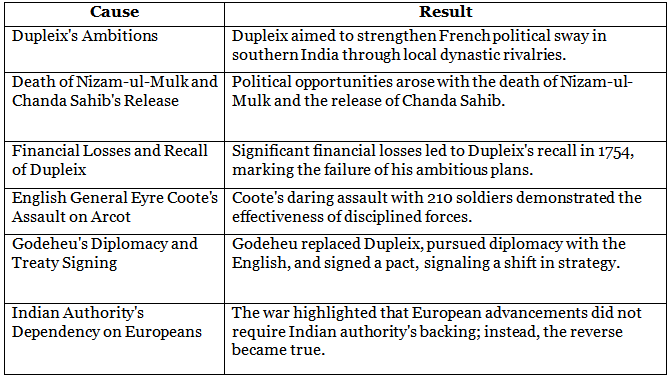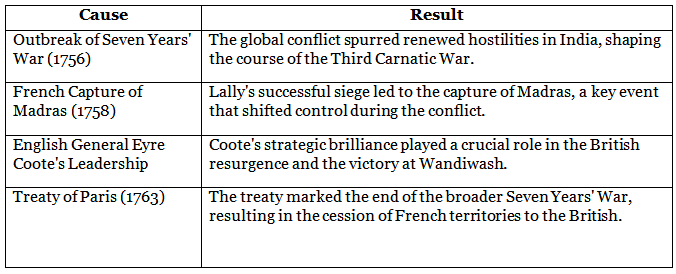Carnatic Wars (1749-1763) – First, Second and Third Carnatic Wars | SSC CGL Tier 2 - Study Material, Online Tests, Previous Year PDF Download
Carnatic Campaigns in the 18th Century
The Carnatic Wars, unfolding along the picturesque Indian coastline during the 18th century, hold a prominent place in the annals of the Indian Military Services. Originating from the princely state of Hyderabad, situated in the heart of India, these wars became pivotal conflicts for the military history of the region.
- Initially propelled to India by trade interests, both the British and the French became intricately involved in the complexities of Indian politics, leading to the commencement of the Carnatic Wars. The genesis of these wars lies in the intense naval and commercial rivalry between France and England, spanning three phases from 1746 to 1763, with a predominant military nature in the early stages.
- The Anglo-French competition in India mirrored the longstanding historical feud between England and France. This rivalry unfolded through the three Carnatic Wars, transforming India into a crucial theater of contestation. Ultimately, it became evident that the English, rather than the French, possessed superior capabilities to assert their authority over India.
From a commercial standpoint, trade emerged as the driving force behind the Carnatic Wars, leaving an enduring impact on the history of contemporary India, rendering it a notable subject for UPSC and the exploration of India's intricate past.
First Carnatic War (1740-48): An Overview
Background:
- European Rivalry: The First Carnatic War was a facet of the global struggle between European powers for colonial supremacy, specifically contested by the British East India Company and the French East India Company.
- Mughal Decline: Occurring during the decline of the Mughal Empire, the war unfolded amidst a power vacuum in India, prompting regional Indian rulers and European colonial powers to vie for influence.
Key Events:
- Siege of Madras (1746): Initiated by Governor-General Joseph Francois Dupleix, the French besieged and captured Madras, held by the British, marking the beginning of the war.
- British Counterattacks: Led by Admiral Edward Boscawen and later Robert Clive, the British launched counterattacks, regaining Madras in 1748, although the situation remained precarious.
- Peace Settlement (1748): The war concluded with the Treaty of Aix-la-Chapelle in 1748, restoring Madras to the British. However, underlying conflicts persisted.

Significance of the First Carnatic War
The First Carnatic War, though relatively brief and inconclusive, holds profound implications in Indian history and the broader colonial rivalry between European powers:
Colonial Rivalry: Signified a significant escalation in the colonial rivalry between the British and the French in India, marking one of the earliest instances of direct military conflicts on Indian soil.
Regional Power Shifts: Contributed to shifting power dynamics in the Carnatic region, involving Indian rulers aligning with European powers, setting the stage for complex alliances and future conflicts.
Introduction of Naval Power: Introduced the importance of naval power in the European competition for supremacy in India, emphasizing control over coastal areas and maritime trade routes.
Role of Indian Allies: Highlighted the pivotal role of Indian allies in the strategies of European powers, showcasing the intricate interactions between Europeans and indigenous rulers.
Treaty of Aix-la-Chapelle: While not decisively resolving the war, the treaty demonstrated the ability of European powers to negotiate and maintain a fragile balance of power in India.
Precursor to Further Conflicts: Set the stage for subsequent Carnatic Wars, with unresolved issues and tensions leading to the Second Carnatic War (1750-1754) and the Third Carnatic War (1757-1763), carrying more far-reaching consequences for the region.
The Second Carnatic War (1749-1754)
Overview: The Second Carnatic War (1749-1754) unfolded as a continuation of the intense colonial rivalry between the British East India Company and the French East India Company in South India. This conflict involved various local Indian rulers, accentuating the complex dynamics of power play in the region.
Background:
- Continuation of Rivalry: Emerging from unresolved issues of the First Carnatic War, the second conflict epitomized the persistent struggle for dominance between the British and the French in South India.
- Regional Indian Allies: The war saw the active involvement of Indian allies, with Muhammad Ali Khan Wallajah supported by the British and Chanda Sahib backed by the French, vying for the Nawabship of the Carnatic.
Key Events:
- Battle of Ambur (1749): Commencing with a significant engagement at Ambur, where Chanda Sahib's forces, aligned with the French, clashed with those of Muhammad Ali Khan Wallajah, the battle set the tone for subsequent conflicts.
- French Advances: Initially, the French, led by Governor-General Dupleix, made substantial territorial gains, capturing key towns and territories in South India.
- British Resurgence: However, the British, under Robert Clive and Major Lawrence, rallied and launched a successful counteroffensive. Crucial battles, including the Battle of Trichinopoly (1751), marked the turning point.
- Treaty of Pondicherry (1754): The war concluded with the signing of the Treaty of Pondicherry, reaffirming Muhammad Ali Khan Wallajah as the Nawab of the Carnatic, and compelling the French to withdraw from several territories.

Significance of the Second Carnatic War:
- British Ascendancy: This war marked a turning point, solidifying British dominance in South India and paving the way for their expanding influence on the subcontinent.
- Failure of Dupleix: Dupleix's failure to achieve long-term objectives showcased the limits of ambitious plans for French dominion in India.
- Territorial Changes: The Treaty of Pondicherry resulted in territorial changes, with Muhammad Ali Khan Wallajah reaffirmed as Nawab and French withdrawal from key territories.
- Local Indian Politics: Involvement of Indian rulers highlighted the intricate interactions between European powers and indigenous leaders, reshaping the political landscape.
- Precedent for Future Conflicts: Unresolved issues set the stage for subsequent Carnatic Wars, influencing conflicts like the Third Carnatic War (1757-1763).
The Third Carnatic War (1757-1763)
Overview: The Third Carnatic War (1757-1763) marked the final chapter in the series of conflicts between the British East India Company and the French East India Company in South India. Amidst the broader global conflict of the Seven Years' War, this war had far-reaching consequences.
Background:
- Continuation of Rivalry: Part of the ongoing colonial rivalry between the British and the French, the war unfolded as an extension of their struggle for territorial and commercial dominance in India.
- Global Conflict: Embedded within the larger Seven Years' War (1756-1763), the Carnatic theater witnessed renewed hostilities between the European powers.
Key Events:
- Outbreak of War (1757): Resuming hostilities in India due to the wider conflict in Europe, the British and French engaged in renewed conflicts in the Carnatic region.
- Siege of Madras (1758): The French, led by Comte de Lally, captured Madras in 1758, initiating a series of events.
- British Resurgence: Sir Eyre Coote's leadership led to the successful recapture of Madras in 1759, with the pivotal Battle of Wandiwash (1760) solidifying British dominance.
- Treaty of Paris (1763): The war concluded with the signing of the Treaty of Paris in 1763, marking the end of the Seven Years' War and resulting in the cession of several French territories to the British.

Significance of the Third Carnatic War:
- British Colonial Ascendancy: The victory in the Third Carnatic War solidified British control in South India, setting the stage for their expanding dominance on the subcontinent.
- End of French Influence: The war effectively ended significant French colonial influence in India, with the Treaty of Paris leading to the cession of French-held territories.
- Eyewitness to India: Sir Eyre Coote's role showcased the military leadership that contributed to the early stages of the British Raj, drawing from experiences in India during this war.
- Global Ramifications: Embedded within the Seven Years' War, the war had broader global implications, influencing colonial boundaries in North America and India.
- Expansion of British Territories: British territorial holdings expanded, becoming integral to the British Empire and shaping colonial India's economic, political, and administrative systems.
- Legacy of Colonial Rivalry: The Third Carnatic War reflected the intense colonial rivalry of the 18th century, contributing to the broader struggle for supremacy in valuable Indian territories.
- Transition to British Raj: The war played a pivotal role in the transition from fragmented rule to the more cohesive rule of the British East India Company, ultimately leading to the establishment of the British Raj.
Key Facts about the Carnatic Wars: Unraveling Historical Narratives
First Carnatic War (1744-1748):
Genesis and Global Turmoil: The conflict emerged in 1744, linked to the global disruptions resulting from the Austrian Succession. It unfolded in the Deccan, witnessing clashes between Anglo-French forces.
European Origins: The French and Dutch states, with historical roots in Europe, played pivotal roles. The British initially underestimated the historical significance of this conflict.
Second Carnatic War (1749-1754):
- Commencement and Contenders: Starting in 1749, the war featured British-supported Muhammad Ali Khan Wallajah against French-supported Chanda Sahib for control of the Carnatic. The Treaty of Pondicherry concluded the conflict in 1754.
- Anglo-French Rivalry: Recognized as a consequential conflict in Indian history, this war marked a defining moment in the fierce rivalry between French and British administrations.
Third Carnatic War (1757-1763):
- War Ignition and Global Ambitions: The war, spanning from 1757 to 1763, was triggered by the Austrian nation's ambition to reclaim Silesia in 1758. France and Britain engaged in a seven-year struggle for dominance.
- Monarchical Influence: European monarchs played central roles in shaping military and political dynamics, impacting events in India.
Common Themes and Significance
Commercial Roots: Initially rooted in commercial competition, the conflicts evolved into complex political and military maneuvers as European powers sought supremacy.
Historical Significance:- European Colonial Expansion: Showcased European ambitions in India, particularly the British and French quest for territorial and commercial dominance.
- Shift in Power Dynamics: Led to a decline in indigenous rulers' influence, marking the ascendancy of European colonial powers.
- Role of Indian Allies: Indian rulers aligning with European powers added complexity and shaped the political landscape.
- Transition to Colonial Rule: Instrumental in the shift from indigenous to European colonial dominance, laying the foundation for British rule.
- Global Context: Linked to broader global conflicts like the War of the Austrian Succession and the Seven Years' War, influencing India's colonial history.
- Treaty of Paris: The 1763 treaty resulted in the transfer of French-held Indian territories to the British, reshaping colonial boundaries.
- Military Leaders: Notable figures like Sir Eyre Coote played key roles, contributing to British ascendancy.
Impact on Indian Politics: Altered the political landscape, with British-backed Nawab Wallajah becoming a central figure in local politics.
Historical Legacy: Essential to India's colonial history, the Carnatic Wars exemplify the intricate interactions between European colonial powers and indigenous forces, serving as a case study of complex historical dynamics.
|
1365 videos|1312 docs|1010 tests
|
|
1365 videos|1312 docs|1010 tests
|

|
Explore Courses for SSC CGL exam
|

|




















